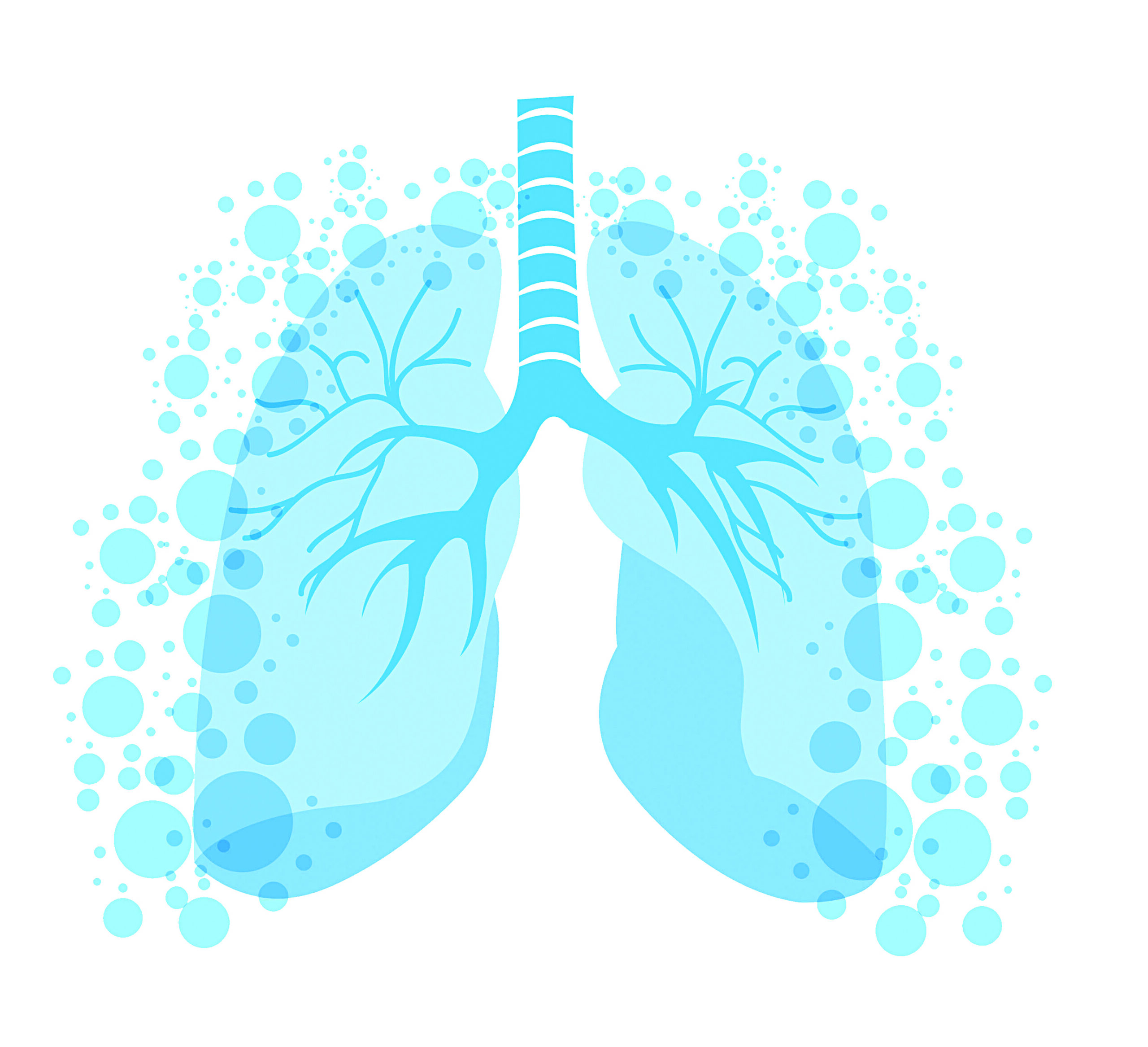A clinical overview of diagnosis, treatment and management of COPD, The second-leading cause of respiratory death in Ireland.
The main symptom of chronic obstructive pulmonary disease (COPD) is an inability to
breathe in and out properly, otherwise known as airflow obstruction. COPD is the name for a group of lung diseases including chronic bronchitis, emphysema, and chronic obstructive airways disease.
After pneumonia, COPD is the second leading cause of respiratory death in Ireland, with only pneumonia causing
more respiratory deaths. Long-term damage to the lungs causes airflow obstruction, with smoking being the cause in 85-to-90 per cent of cases.
Approximately 500,000 in Ireland live with COPD, according to the Irish Thoracic Society. It generally presents
in people over 40 who have a history of smoking. It is more common in men than women but according to the British Thoracic Society, the rate of COPD in women is increasing. Smoking is the cause of 90 per cent of COPD cases in developed countries. The Global Burden of Disease Studies estimates it is the fifth commonest cause of disease morbidity, and the third-commonest cause of death worldwide, causing more deaths than lung cancer, heart disease and stroke
Because of the prevalence of smoking in young people in Ireland, it is predicted that Ireland will continue
to have one of the highest prevalence of COPD in the world.
Types
Chronic bronchitis: Bronchitis means ‘inflammation of the bronchi’. Inflammation caused by the likes of smoking damage increases mucus produced in the airways which causes the classic COPD cough.
Emphysema: this is where the alveoli (air sacs) in the lungs lose their elasticity, causing them to get narrower.
It also means the lungs are not as good
in and out will becomes difficult. This is called airway limitation. It makes normal activities, such as walking up the stairs, difficult. If not enough oxygen is getting through the narrowed airways to the heart, the patient may also be at risk of heart failure. The World Health Organisation’s GOLD definition for airflow limitation is an FEV1/
FVC ratio of ? 70%.12 The FEV1/FVC ratio is a calculated ratio used in the diagnosis of
lung diseases such as COPD. It is a measure of the proportion of forced vital capacity exhaled in the first second. Normal values are approximately 80 per cent.
The symptoms of COPD can seem like those of asthma. Asthma can be controlled with medication, but COPD cannot be reversed or cured due to permanent lung damage. COPD is non-reversible, so treatment for COPD involves relieving the symptoms, ie, bronchodilators.
Symtoms
- Early morning smoker’s cough.
- Persistent coughing.
- Wheezing.
- Tight chest.
- Difficulty breathing.
- Shortness of breath.
- Repeated lung and chest infections.
The symptoms are often worse in winter. Because the amount of oxygen reaching the
heart and muscles is diminished, COPD can make patients feel tired. This impacts negatively on the ability to work and exercise and as the disease progresses, even simple everyday activities are difficult.
Many with COPD experience weight loss, as having difficulty breathing can lead to the patient using up a lot more energy. Also, the breathlessness can make it difficult to eat as much as normal. Significant weight loss can cause weakening of the heart and lead to heart failure. Not everyone with COPD experiences weight loss can cause weakening of the heart and lead to heart failure. Not everyone with COPD experiences weight loss and in fact, obesity makes COPD worse
Classic signs include
quiet breath sounds or
rhonchi (rattling sound
when breathing),
peripheral oedema and
chest hyperinflation
First signs of COPD
When to refer to a GP is at the first signs of COPD which include:
- An increasing breathlessness when excercising or moving around.
- A persistent couch with phlegm that never seems to go away.
- Frequent chest infections, particularly in winter
Classic signs include quiet breath sounds or rhonchi (rattling sound when breathing), peripheral oedema and chest
Causes
Smoking causes over 80 per cent of COPD cases. The risk of COPD increases the more the patient smokes and the longer they smoke. Between the ages of 35-to-45, everyone’s lung function begins to gradually decline. For smokers, this loss of lung function speeds up to around three times the normal rate.
While not all smokers develop clinically significant COPD, studies show that most smokers, if they live long enough and smoke enough, will develop airflow limitation.
It is estimated that less than 20 per cent of smokers develop significant airway obstruction.17 This is
likely to be down to the fact that many smokers stop smoking before significant lung damage occurs.
Less common causes of COPD include:
- Passive smoking
- Pollution
- Fumes and dust
- Being born more suspectible to the condition (genetic link).
Worldwide, up to 20 per cent of COPD patients are life-long non-smokers.
Prognosis
Five-year survival for men with mild disease is 78 per cent and with severe disease, it is 32 per cent, with corresponding figures for women being 72 per cent and
24 per cent.
Diagnosis
Diagnosis will be decided when there is a combination of chronic progressive symptoms and a history of exposure to risk factors like smoking and will include spirometric evidence airflow blockage. Common symptoms include shortness of breath (persistent and progressive), cough, sputum, wheeze (particularly early morning) and exercise intolerance. Classic signs include quiet breath sounds or rhonchi (rattling sound when breathing), peripheral oedema and chest hyperinflation. Tests to rule out other conditions such as asthma and include:
Spirometry — this involves blowing into and out of a tube called a spirometer. This establishes lung function and determines if the airways have narrowed.
Chest radiography — a chest x-ray determines if there is an expansion of the lungs, which can point to COPD.CT scan — a CT scan can give a more definitive diagnosis of different lung diseases than a chest x-ray.
Blood test — this can show if the patient is suffering from anaemia, which can make COPD symptoms worse. A blood test may also be used to check for polycythaemia (an excess of red blood< cells). Polycythaemia shows the body is Plasma theophylline concentration is decreased in smokers, with alcohol and with drugs that increase metabolism. Plasma theophylline concentration should be checked regularly. Due to the risk of potential side-effects, such as increasing heart rate and headaches, other options such as a bronchodilator are usually tried first before considering theophylline. Side-effects can also include nausea and other gastrointestinal problems, palpitations, and insomnia.
Mucolytic tablets or capsules Mucolytics, such as carbocisteine, thin mucus and phlegm, allowing it to be coughed-up easier. Their effectiveness is questionable. They may be beneficial for patients with moderate and severe COPD, who have frequent or bad flareups, ie, Viscolex liquid, Exputex liquid,Erdotin caps
Antibiotics and corticosteroids
Patients with COPD often suffer from chest infections, so are frequently prescribed a short course of broad-spectrum antibiotics such as amoxicillin, tetracycline, or erythromycin. Oral corticosteroids may be needed in short courses of one or two weeks for acute flare-ups. They should be commenced as the flare-up starts for best effect. Steroids (30mg prednisolone for seven-to-10 days) are of most benefit when the FEV1 is <50% predicted and if the patient has had two or more exacerbations in the previous year.11 Long-term use of corticosteroids cause side-effects, including weight gain, osteoporosis, stomach ulcers and fluid retention. Side-effects are minimal for short-term courses. They should be taken as a single dose in the morning and after food. Enteric coated versions such as Deltacortril reduce stomach irritation
Longer-term maintenance antibiotic The use of long-term maintenance (prophylactic) antibiotic is sometimes considered for patients at increased risk of acute exacerbations of COPD. They are shown to have anti-inflammatory effects, which has as much benefit as
their antibacterial effect. Macrolides like azithromycin and erythromycin are most frequently prescribed and seem to infer the most antiinflammatory effect of all antibiotics for prophylactic use in COPD.22 Fifty-two per cent of patients with frequent acute exacerbations of COPD have induced sputum that was most colonised with Haemophilus influenzae, S.pneumoniae, H.parainfluenzae, and Moraxella catarrhalis
Oral corticosteroids
may be needed
in short courses of
one or two weeks for
acute flare-ups
Antibiotic maintenance therapy is azithromycin 250mg once daily (or 250mg three days per week), for one year has been shown to reduce the frequency of acute exacerbations.21 This decrease was accompanied by a decrease in the incidence of colonisation with selected respiratory pathogens and improved quality of life. Studies have not established the safety of azithromycin as maintenance therapy for more than one year.21 Azithromycin is contraindicated if a resting heart rate greater than 100 beats per minute, a prolonged corrected QT (QTc) interval (>450 msec)and with confirmed hearing problems.Safety concerns regarding antibiotic resistance need to be addressed before widespread use in practice.
Nebulisers Used to administer bronchodilators and corticosteroids in severe COPD, as they allow administration of large doses of the drug. If relief from nebulised bronchodilators is not sufficient, intravenous aminophylline may be needed.
Other Types of Treatment
Long-term oxygen therapy In severe or end-stage COPD, when the oxygen in the blood gets very low, the patient may need oxygen therapy. Hypoxic patients (PaO2 < 7.8 kPa) with evidence of cor pulmonale (enlargement of right ventricle in heart) have a five-year survival of less than 50 per cent.11 Longterm oxygen therapy has been shown to increase survival in persistent daytime hypoxaemia (PaO2 < 7.3 kPa).13,14,15 There is no survival benefit of oxygen in patients with lesser degrees of hypoxaemia.16 However, oxygen does increase survival for patients with severe chronic COPD with hypoxaemia. Oxygen must be used for at least 15 hours a day. The tubes from the machine are long enough to enable a patient to move around their home while connected. Patients must not smoke when using an oxygen concentrator due to fire risk.
Hospitalisation
In rare cases, hospitalisation may be
required for exacerbations of COPD.In hospital, patients usually receive oxygen, antibiotics (if necessary) and a nebuliser to help ease symptoms. Hospitalisations give better outcomes in acute exacerbations.
Lung transplantation
Lung transplantation is rare in cases of COPD and it is usually only suggested if life expectancy is less than two years.Although lung transplantations are usually very successful, the patient will need to take immunosuppressants medication for the rest of their life to prevent organ rejection.
Lung volume reduction surgery(LVRS)
Lung volume reduction surgery (LVRS)is when the damaged parts of the lung are removed during surgery. It improves symptoms but increases pneumonia risk and risk of developing an air leak where the lung has been re-sealed.
Preventing COPD
There are aspects of lifestyle that a patient can change to reduce the risk of developing chronic obstructive pulmonary disease (COPD), or to help ease symptoms.
Give up smoking
While much of the damage may have been done if smoking long enough,stopping smoking slows down disease progression. If symptoms of COPD are mild, stopping smoking may be all that is needed to significantly improve them.
Get regular exercise
Regular exercise strengthens the heart and lungs and improves breathing. Build up gradually if not used to exercising.The aim is to do a minimum of 30 minutes of exercise a day, at least five times a week. Losing weight if overweight can also be beneficial because extra weight can make breathlessness worse.
Eat a balanced diet
A balanced diet helps the immune system and will help fight-off infection.Plenty of fruit and vegetables (at least five a day) and reduced fat, sugar, and salt will help.
Drink plenty of fluids
Drink plenty of fluids, particularly water, to help to reduce the amount of mucus and phlegm in the throat and lungs.
Use a steam inhalator or humidifier
A steam inhalator or humidifier can be used at home to help to reduce excess mucus and phlegm. They can also reduce the feeling of being blocked up and being unable to breathe properly.
Physiotherapy
Physiotherapy can be used to clear excess mucus from the airways.
Get vaccinated
Patients with COPD are at greater risk of catching other illnesses, such as influenza (flu).They should therefore have an annual flu jab every autumn (September to November). Pneumococcal vaccine is also recommended. Protection from the pneumococcus vaccine lasts for five years or longer. Patients with nephritic syndrome (kidney damage), splenic (injury to spleen) or splenic dysfunction (no spleen) may need additional vaccinations. Due to increased risk from Covid-19; patients with COPD were prioritised in the Covid-19 vaccine roll out.
Copd and flying
Before flying, the patient should check with their GP to ensure they feel they are fit to fly. Before travelling, remember to pack all medication, such as inhalers, in hand luggage. A letter from doctor or pharmacist explaining why the medication is needed is advised. Patients using oxygen therapy should inform the travel operator and airline before booking a holiday, as a medical form may be needed from their GP.
Covid 19 and COPD
Having COPD can put patients at a higher risk of serious illness if they get coronavirus (Covid-19). Hence, they were prioritised COPD patients in the Covid-19 vaccine programme.
Disclaimer: Brands mentioned in this article are meant as examples only and not meant as preference to other brands.
CONTRIBUTOR INFORMATION
Written and researched by
Eamonn Brady (MPSI), owner of
Whelehans Pharmacies in Mullingar
Tel 04493 34591 (Pearse St) or
04493 10266 (Clonmore). www.
whelehans.inet. Eamonn specialises in
the supply of medicines and training
needs of nursing homes throughout
Ireland. Email ebrady@whelehans.ie
References
- National Medicines information Centre; St James’s Hospital,
Dublin 8. Chronic Obstructive Pulmonary Disease; Volume 10,
Number 3, 2004;p1. - Murray CJ, Lopez AD. Mortality by cause for eight regions
of the world: Global Burden of Disease Study. Lancet 1997; 349:
1269-76. - Murray CJ, Lopez AD. Global mortality, disability, and the
contribution of risk factors: Global Burden of Disease Study.
Lancet 1997; 349: 1436-42. - Murray CJ, Lopez AD. Alternative projections of mortality
and disability by cause 1990-2020: Global Burden of Disease
Study. Lancet 1997; 349: 1498-504. - White J, Winter R, Chilvers E. COPD: recent advances.
Horizons in Medicine 2003; 14: 373-82. - Barnes PJ. Small airways in COPD. NEJM 2004; 350:
2635-2635. - Brennan N, O’Connor T. Ireland Needs Healthier Airways
and Lungs – the evidence. June 2003. - Barnes PJ. Small airways in COPD. NEJM 2004; 350:
2635-2635. - Pauwels RA, Rabe KF. Burden and clinical features of
chronic obstructive pulmonary disease (COPD). Lancet 2004;
364: 613-20. - Rennard S. Looking at the patient – approaching the
problem of COPD. NEJM 2004; 350:965-66. - NICE Guidelines on management of COPD. Thorax 2004; 59
(Supp 1): 1-232 Clinical guideline 12, developed by the National
Collaborating Centre for Chronic Conditions. - Global Initiative for Chronic Obstructive Lung Disease.
Updated 2003; www.goldcopd.com. - Continuous or nocturnal oxygen therapy in hypoxaemic
chronic obstructive lung disease: A clinical trial. Nocturnal
Oxygen Therapy Trial Group. Ann Intern Med 1980; 93: 391. - Long-term domiciliary oxygen therapy in chronic hypoxic
cor pulmonale complicating chronic bronchitis and emphysema.
Report of the Medical Research Council Working Party. Lancet
1981; 1: 681. - Cochrane Database system – Domiciliary oxygen for COPD.
Cochrane Database of Systemic Reviews 2000;(2):CD001744. - Gorecka D, Gorzelak K, Sliwinske P et al. Effect of longterm oxygen therapy on survival in patients with chronic
obstructive pulmonary disease with moderate hypoxaemia.
Thorax 1997; 52: 674. - David M Mannino. COPD: Epidemiology, Prevalence,
Morbidity and Mortality, and Disease Heterogeneity. Chest
2002; 121;121S-126S. - Cheyne, Irvin-Sellers, White. Tiotropium versus ipratropium
bromide for chronic obstructive pulmonary disease. Cochrane
Airways Group, Sep 2015. - Nannini, Poole, Milan, Holmes, Normansell; Combined
corticosteroid and long-acting beta2-agonist in one inhaler
versus placebo for chronic obstructive pulmonary disease.
Cochrane Airways Group, Nov 2013. - Patel IS, Seemungal TAR, Wilks M, Lloyd-Owen SJ,
Donaldson GC, Wedzicha JA. Relationship between bacterial
colonisation and the frequency, character, and severity of COPD
exacerbations. Thorax 2002; 57:759-764. - Azithromycin for Prevention of Exacerbations of COPD. New
England Journal of Medicine 2011; 365:689-698. - Anthony W Huckle, Lucy C Fairclough and Ian Todd.
Prophylactic Antibiotic Use in COPD and the Potential AntiInflammatory Activities of Antibiotics. Respiratory Care May
2018, 63 (5) 609-619







